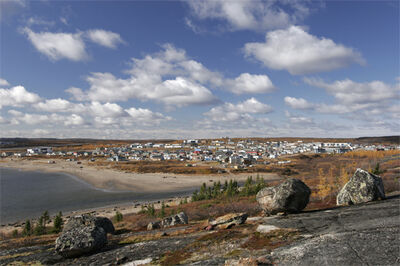
The flag of the Republic of Quebec.
The logo of the Quebec Conservative Party.

The Golden Eagle and the Scroll, the symbol of the First Nations movement.

The village of Kuujjuaq, the starting point of the Quebec Civil War.
On October 30 1995, Quebec successfully seceded from Canada by way of referendum. It was an incredibly close decision, with a vote totaling at 50.1% voting Yes and 49.9% voting No. The Republic of Quebec immediately engaged in seeking recognition from other nations, as rebellion started to erupt within their borders.
The First Nations of Quebec were denied negotiations in the constitutional writing, which had they had proposed in order to prevent cultural tension. The first president of Quebec, the lieutenant governor at the time, Martial Assel, had denied First Nation negotiations due to "time constraints". As a result, the First Nations were not granted the same protections they were given under Canadian rule. Heavy tensions grew, as many aboriginals began talking of ways to be free of Quebec rule, from autonomous regions, to partitions, and even wars.
After the Quebec Army was fully built up, a basic stock exchange established, the constitution written, and Martial Assel two years into his first three-year term in 1997, there was a rising opinion that Quebec should offer land to farmers and possibly even First Nation people. When the first Quebec presidential election rolled around in 1998, the decision was a hot topic. Assel was against land purchasing, saying it could damage the economy, and so he lost much of the vote from rural Quebecers. An up and coming politician from the Conservative Party, Pierre Comeau, campaigned actively on land purchasing for ambitious farmers, who now made up a majority of the voting population, along with First Nationers. Comeau won by direct popular vote, ahead by seven hundred thousand votes.
Immediately once he came into office in 1999, President Comeau worked towards land purchases for the Quebec people. However, he did not factor in the many First Nationers who voted for him. After a few parliamentary sessions, the decision was finalized. Quebec would attempt to purchase from Canada, Newfoundland and Labrador to build new neighborhoods and factories, and Nova Scotia for the farmland. No mention was made about First Nations.
In 2000, the purchases were dealt with Canada, and the two provinces became provinces of Quebec. Around this time, the First Nations had had enough. Tired of a lack of rights that they had tirelessly worked for through political rallies, petitions, and political candidates, they decided to turn to the only solution possible. Civil War.
An alliance of the main First Nations was formed, with the Inuits providing support. The total number of troops formed totaled at about 67,000. During the night of October 14 2001, the First Nation Alliance raided the non-indigenous populated areas of Kuujjuaq and occupied the village, calling it the new interim capital of the First Nation Democratic Republic. Police forces were dispersed and tried brutally to drive out the First Nationers, but they failed, albeit at great cost to the city garrison. Calls from other nations to stop the violence grew and grew, until the First Nationers captured the county. At that time, Canada indirectly joined the side of the First Nationers, providing army support at the city garrison in Kuujjuaq. With the help of mild Canadian air support, the First Nationers occupied the Northern Half of Kativik. However, to guarantee the support of the Canadians, they did not kill or brutalize any POW's from the towns they raided.
The Quebec Army was finally sent to attack the occupied towns in January of 2002, sending Quebec into a civil war. The First Nationers did not let up their occupation of towns, with support of the indigenous populations. After the Canadians finally pushed back the Quebec offensive line in September 2002, President Coumer proposed a solution. The First Nation would be granted an autonomous region in the northern half of Kativik, but the First Nation-associated political parties would not be able to send Presidential candidates. In a surprising turn of events, the council of the First Nation Democratic Republic accepted. The Quebec Civil War was over.
By 2010, Quebec had become a great power in North America. President Coumer was impeached for his actions in the Quebec Civil War, and was replaced by the Prime Minister, Jean-Paul Bouvier. The autonomous region of Terrain de Premières Nations du Québec is flourishing with human rights for the indigenous. And so far, Quebec has been doing better than ever before.
